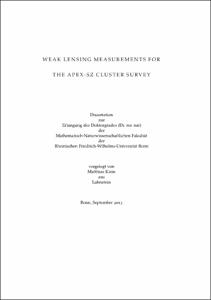Weak lensing measurements for the APEX-SZ cluster survey

Weak lensing measurements for the APEX-SZ cluster survey

| dc.contributor.advisor | Bertoldi, Frank | |
| dc.contributor.author | Klein, Matthias | |
| dc.date.accessioned | 2020-04-20T04:16:10Z | |
| dc.date.available | 2020-04-20T04:16:10Z | |
| dc.date.issued | 02.12.2014 | |
| dc.identifier.uri | https://hdl.handle.net/20.500.11811/6211 | |
| dc.description.abstract | The formation of structures in the universe, such as galaxy clusters, depends sensitively on cosmological parameters. Measuring the abundance of clusters as a function of mass and redshift therefore yields a way to constrain those parameters at high accuracy. In this context a major task is to reliably constrain the scaling relation between the observables used to estimate the cluster mass and the true mass. Gravitational lensing is the deflection of light from distant galaxies by the mass of a cluster. Observations of this deflection allow to measure the total mass distribution of galaxy clusters without making assumptions about the dynamical state of the cluster. This thesis describes the weak gravitational lensing observations of all redshift z < 1 clusters that were previously detected via the Sunyaev-Zel’dovich (SZ) effect with the APEX-SZ instrument on the APEX telescope. The combination of archive data and followup observations with the 2.2m telescope at La Silla, Chile, provided sensitive imaging of 39 galaxy clusters in three optical filters. The redshift distribution of galaxies in color and magnitude space was investigated using a deep photometric reference catalog and allows us to derive individual distance estimates for each galaxy in the observed field. The individual distance estimates are used to select a signal to noise optimized galaxy catalog suitable for weak lensing measurements. This new method reduces the scatter and the systematic effects that arise from cosmic variance in the cluster and the reference fields. The individual distance estimates allow to map the distribution of cluster galaxies, providing important insights to the cluster dynamics and matter distribution. A modified version of the method was used to derive accurate estimates of cluster redshifts. The comparison of these redshift estimates with spectroscopic redshifts of eleven clusters showed a scatter that is four times smaller than that found for commonly used methods. The derived lensing masses were used to study the scaling relation between mass and integrated Compton-y parameter, YSZ, using preliminary results of 29 clusters observed with APEX-SZ. Measurements of 17 clusters by the Planck satellite are used furthermore to analyze the mass-YSZ scaling relation for the Planck SZ measurements. The scaling relations found for APEX-SZ and Planck measurements are in agreement with each other and with prior published work. Excluding two potential outliers yields slope parameters that are in good agreement with self-similar evolution. Five clusters were studied in greater detail, using weak lensing, SZ and X-ray maps. The developed methods to map cluster member galaxies were used to verify the mass distribution found in the lensing convergence maps. The newly developed method to derive cluster redshifts was applied to the observed substructures to verify their physical proximity. Two clusters are recognized as undergoing a major merger event, showing either shock fronts in the intracluster medium (ICM), or a large spatial separation between the ICM and the position of the main dark matter concentrations. One of these clusters may show the largest offset between dark matter and ICM known so far. | en |
| dc.language.iso | eng | |
| dc.rights | In Copyright | |
| dc.rights.uri | http://rightsstatements.org/vocab/InC/1.0/ | |
| dc.subject | Galaxienhaufen | |
| dc.subject | Kosmologie | |
| dc.subject | Gravitationslinseneffekt | |
| dc.subject | Skalierungsrelation | |
| dc.subject | Photometrische Rotverschiebung | |
| dc.subject | Galaxy clusters | |
| dc.subject | Cosmology | |
| dc.subject | Gravitational lensing | |
| dc.subject | Scaling relation | |
| dc.subject | photometric redshifts | |
| dc.subject.ddc | 520 Astronomie, Kartografie | |
| dc.subject.ddc | 530 Physik | |
| dc.title | Weak lensing measurements for the APEX-SZ cluster survey | |
| dc.type | Dissertation oder Habilitation | |
| dc.publisher.name | Universitäts- und Landesbibliothek Bonn | |
| dc.publisher.location | Bonn | |
| dc.rights.accessRights | openAccess | |
| dc.identifier.urn | https://nbn-resolving.org/urn:nbn:de:hbz:5n-38481 | |
| ulbbn.pubtype | Erstveröffentlichung | |
| ulbbnediss.affiliation.name | Rheinische Friedrich-Wilhelms-Universität Bonn | |
| ulbbnediss.affiliation.location | Bonn | |
| ulbbnediss.thesis.level | Dissertation | |
| ulbbnediss.dissID | 3848 | |
| ulbbnediss.date.accepted | 18.12.2014 | |
| ulbbnediss.institute | Mathematisch-Naturwissenschaftliche Fakultät : Fachgruppe Physik/Astronomie / Argelander-Institut für Astronomie (AIfA) | |
| ulbbnediss.fakultaet | Mathematisch-Naturwissenschaftliche Fakultät | |
| dc.contributor.coReferee | Schneider, Peter |
Files in this item
This item appears in the following Collection(s)
-
E-Dissertationen (4442)




